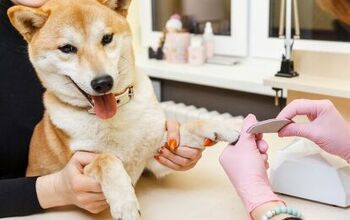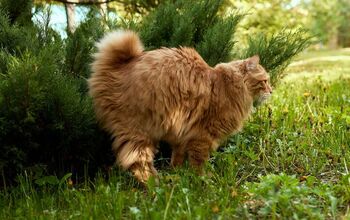How Do I Create a DIY Busy Box for My Dog?

Just like humans, dogs require mental and physical stimulation for their overall well-being and happiness. It’s essential for creating an environment where they can thrive by reducing stress, preventing boredom, eliminating unwanted behaviors, and strengthening the human-animal bond. Unfortunately, many dog parents feel overwhelmed with the many products on the market (and the costs associated with them).
In this article, I will break down the five types of enrichment your dog requires to live their best life. I have also included examples for each type, many of which are free or low-cost! Finally, I will walk you through how to make one of our favorite enrichment activities here in our house, the busy box, step-by-step.
Let’s get started…
5 Types of Dog Enrichment
When people talk about enrichment for dogs, they often focus on two forms – physical enrichment and mental enrichment. But you may be surprised to learn that there are five types to consider, each with unique benefits for your dog. To provide the best possible quality of life for your dog, you will need to consider how to find (or create) opportunities for all five types of enrichment.
Physical
Just as we must be physically active for our health and well-being, so do our dogs. The amount of exercise your dog needs will vary from dog to dog, depending on their age, breed, and lifestyle. For example, a high-energy puppy will need more daily activity to feel satisfied than a senior dog, and a high-energy working breed will need more exercise than a calm, companion breed. Physical enrichment includes everything from walking around the block or playing fetch in the backyard to navigating a challenging hiking trail. The goal is to get up and moving.
Nutritional
Activities that fall under the nutritional enrichment category require your dog to hunt or forage for their food. This includes food puzzles, treat dispensing toys and snuffle mats. But you don’t have to purchase a fancy product to incorporate nutritional enrichment. One easy (and free) solution is to hide treats around the room and watch your dog sniff out the rewards. Games like this tap into your dog’s natural instincts.
Social
With the recent boost of dogs being adopted during the lockdown, this is a need that many new dog parents didn’t meet. Not because they didn’t want to, they simply didn’t know better. But socialization is essential to raise a well-behaved and well-adjusted dog. The key to socializing your dog correctly is to do it slowly and under careful supervision.
Allow your dog to discover new people, places, and things without feeling frightened or in danger. If you are letting your dog meet a dog for the first time, it should be done carefully with both dogs under control to prevent fights or other unpleasant situations. This is why so many dog trainers discourage dog parks and off-leash areas. Many well-meaning dog parents will bring their pups to these locations only to have them rushed by an “overly friendly” dog, causing overstimulation which can lead to fear or aggression. Instead, consider signing up for a puppy training class or arranging supervised puppy play dates with a dog lover you know and trust.
In addition to introducing your dog to other dogs, social enrichment should include interactions with people, cats, objects (like cars and bicycles), and new environments. Make sure you are in control heading into each experience, and remove your dog quickly if you see they are becoming overwhelmed.
Sensory
Have you ever sat down at the park just to people-watch? Do you enjoy closing your eyes and listening to your favorite music after a long day at work? Do you use scented candles to create a comforting and calming scent in your home? These are all examples of ways sensory enrichment can play an important role in our lives, and the same goes for our dogs.
Sensory enrichment aims to incorporate different senses into play and their daily activities. This could mean doing nose work activities, playing hide and seek, or setting your living room up for people watching out the front window.
Occupational
Finally, occupational enrichment is essential for working dogs, like herding dogs. Having been bred to perform a specific job or task, they have a deep-seated need to carry out that purpose. This is why you see dogs like the Australian Cattle Dog often instinctually trying to herd the family cat, other dogs in the home, or even small children. While allowing those behaviors in the home daily could lead to a dangerous situation, there is another solution – give them a job to direct this energy toward.
Take a moment to consider what your dog was bred to do and how you can let them do something similar today. This could include dog sports like joring, focused training sessions, or introducing your dog to a herding ball.
Can You Give Your Dog Too Much Enrichment?
As with everything in life, your enrichment activities should be offered in moderation, especially if they involve food. Too many treats can easily lead to unwanted weight gain and the many risks of obesity.
There is also a risk that a well-meaning dog parent could fall into the trap of using enrichment activities to mask training issues. If you need to use enrichment activities constantly to distract your dog from unwanted behaviors, it may be time to step back and get to the root of the problem. For example, addressing a dog’s separation anxiety is a better long-term solution for everyone than just trying to distract your dog anytime someone leaves the house.
How to Create a DIY Busy Box on a Budget
There are many great enrichment toys and products out there for you to choose from. However, as any dog parent can attest, those costs can add up fast! With three dogs in our house, all different sizes and different preferences for types of enrichment, we knew that we needed to start exploring some of the more budget-friendly options. That’s when we were introduced to the idea of a DIY Busy Box.
Step One: Gather Your Supplies
These can be constructed entirely for free using items around the home. However, if you want to be able to set this up and do it regularly, we recommend purchasing a large Rubbermaid-style bin with a lid. This will serve as the base of the busy box but will also store items between uses to make everything easier to find.
In addition to the bin, you will need some items to create “obstacles” in the box and one meal of your dog’s kibble or a handful of treats if it isn’t mealtime.
Some items you could use for this include:
- Empty small cardboard boxes like Kraft Dinner boxes
- Empty egg cartons
- Cardboard rolls from your paper towels
- Old towels
- A few of your dog’s toys
Step Two: Fill the Smaller Boxes
Take some kibble and place it inside of the smallest boxes, folding them closed. This will mean your dog will need to open the box to get their food. If you have an assortment of different box sizes, you can increase the difficulty of the busy box by placing food in the smallest box, then putting this inside a slightly larger box. Egg cartons can be used similarly, placing kibble in each little egg cup before closing it.
For the cardboard rolls, take one end of the roll and gently press on the side until the roll folds in on itself, creating a curved end. Do this on the other side of this end of the roll, and you will have sealed off the tube, similar to how people create DIY gift boxes (as pictured above). Fill the tube with some kibble before sealing the other end using the same technique.
Step Three: Create Towel Snuffle Toys
Take an old towel out and lay it flat on the ground. Sprinkle some kibble across the towel’s surface before lightly rolling it or folding it. You can continue to sprinkle kibble as you go, folding or rolling until you’re happy with the size. Repeat this process to create as many or as few snuffle toys as you wish. For an extra challenge, tie a rolled towel in a knot.
Caution: If your dog is a heavy chewer or loves ripping up stuffed toys, you may want to skip this part. Towels can be ripped up relatively easily and swallowed, leading to a dangerous blockage.
Step Four: Assemble the Busy Box
Place your filled boxes and towel snuffle mats inside your large bin. You can move items around as needed to get everything to fit. If you notice small gaps in the box that you want to fill, use some of your dog’s favorite toys to fill those spaces. The better packed in it is, the more they will have to work to pull everything out.
Sprinkle any leftover kibble for your dog’s meal around the box as you assemble it, allowing it to fall in the nooks and crannies for an added surprise.
Step Five: Stand Back and Have Fun!
Now that your DIY Busy Box is assembled place it on the ground, stand back, and enjoy the live entertainment. Your dog will sniff through, pulling items out and searching for all the tasty goodies the box hides. This challenges them to forage, do nose work, and problem solve – especially if you included some of the added challenges like boxes within boxes.
Ensure you always supervise them as they go through the box. There is always the chance that they may rip something apart (like a cardboard box) or come across something that could pose a risk if ingested. Take any troublesome pieces away promptly.
Final Thoughts: Enrichment and Your Dog
Don’t let your budget keep you from introducing new and fun enrichment opportunities into your dog’s life. As I shared in the examples above, there are free or low-cost options for each of the five types of enrichment, from playing hide and seek or going for a walk to training sessions and building a busy box out of your recyclables. The options are endless!

Britt Kascjak is a proud pet mom, sharing her heart (and her home) with her “pack” which includes her husband John, their 2 dogs – Lucifer and Willow – and their 2 cats – Pippen and Jinx. She has been active in the animal rescue community for over 15 years, volunteering, fostering and advocating for organizations across Canada and the US. In her free time, she enjoys traveling around the country camping, hiking, and canoeing with her pets.
More by Britt

























